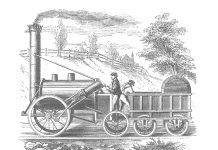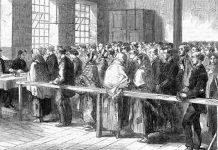It was one of the country’s earliest examples of a reformist prison. Its foundation stone was laid by Thomas Butterworth Bayley, chair of the quarter sessions and ardent admirer of the prison reformer John Howard.
It was christened ‘New’to distinguish it from London’s ‘Old’and now a unique opportunity is currently underway to excavate its foundations before the developers Muse begin work on the latest part of Salford’s regeneration.
New Bayley Prison was first opened in 1787, a successor to Hunt’s Bank near Current day Victoria Station but it would survive as a prison for just eighty years, before Manchester’s growing population proved too immense for it and was succeeded by Strangeways.
During its short life it would house a future Mayor of the City, Abel Heywood, jailed for four months in 1832 for refusing to pay a fine for selling an unstamped newspaper.
Now a team of archeologists are working to unearth its secrets before its site is used to build a 125,000 sq ft state of the art office development.
 The dig, organised by Salford University, has so far uncovered rows of tiny prison cells, which Mike Neville tells us would have been on two levels and be around 7ft by 5ft, barley enough room for a prisoner to lay down.Each group of cells would have had a dayroom where the inmates would have been fed and from where they would have been led daily to the small workhouses and a walled exercise yard.
The dig, organised by Salford University, has so far uncovered rows of tiny prison cells, which Mike Neville tells us would have been on two levels and be around 7ft by 5ft, barley enough room for a prisoner to lay down.Each group of cells would have had a dayroom where the inmates would have been fed and from where they would have been led daily to the small workhouses and a walled exercise yard.
Previous work had exposed what was left of the prison’s notorious treadmill, first introduced in 1824 where prisoners sentenced to hard labour would toiled for ten hours a day and though initially used to grind dye wood, were for the last thirty years of its life, simply driving the air.
But this was not a harsh prison.Howard had argued that prisoners required provisions for healthcare, education and religion with an emphasis on reform through punishment. It was run on what was refered to as the separate system where inmates were placed in individual cells in which they slept and worked.
Inmates would carry on productive labour in the workshops which included Hand Loom weaving, winding bobbins, wool picking and rope making. Prisoners were allowed to keep one sixth of their earnings which was given to them on release.
The food was probably better than many would have recieved in the outside. A quart of gruel daily for breakfast, three days of the week, 5oz of boiled beef without bone, a pound of potatoes and 7oz of brown bread. on Saturdays a stew with onions and the other days a quart of pease soup.
It was said that many released would cry and hanker to remain inside.
The system at New Bailey was so successful that it became law in 1865. By then though, the New Bailey was coming to the end of its short life. Belle Bue Jail had opened but was already filled to capacity and the authorities commissioned the architect Alfred Waterhouse to design a new prison near to the site of Strangeways Hall.
The New Bailley closed in 1868 and was purchased by the Lancashire and Yorkshire railway, serving as a railway yard.Mike tells us that whoever cleared the land did a good job for the archelogy team has found barely any artefacts on the site.







